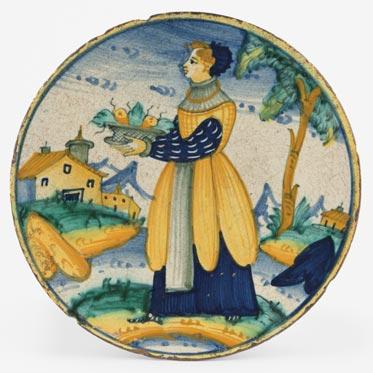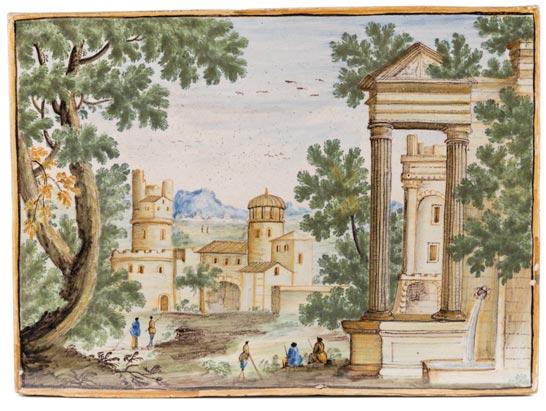
6 minute read
CASE 21 CASTELLI
from Tin Glaze
Castelli is a small town high up in the mountains of the Abruzzi region of Italy and a remarkably isolated place to have been a productive centre of artistic maiolica for centuries until the present day. The sixteenth century saw notable production, especially numerous attractive pharmacy jars, made in the workshops of the Pompei family [nos. 201, 202], but the golden age of Castelli istoriato began in the first half of the seventeenth century. The most prominent maiolica-making family over several generations was the Grue dynasty, notably Francesco (1618–1673), Carlo Antonio (1655–1723), and Francesco Antonio Saverio (1686–1746). Other notable ceramic families were the Gentili and the Cappelletti; these families were linked by intermarriage.
The town was part of the Kingdom of Naples and Castelli potters had clients especially among the aristocracy of Naples [nos. 182, 183]; but, they also had markets in Rome and internationally in the eighteenth century. Several Grand Tourists from England and elsewhere brought back examples to their native countries.
Castelli potters made extensive use of engravings and also of drawings and tracings pounced for direct transfer. This and the relative paucity of signed pieces (with the notable exceptions of Francesco Antonio Grue and Carmine Gentili), together with the close links between the principal families, makes attribution to individual artists often hazardous, especially in the case of landscapes. More Castelli maiolica is shown in case 33.
Bibliography: Corrieri 1998; Arbace 1998, 2000, 2002, 2005, and 2020; Hess 1999; Battistella and de Pompeis 2005.
121
Plate on high foot, An allegory of Europe
Castelli, c1670–1680
MAK, KE 5953
Hauptinventar no. 16559r
Bought 1907 from Puschgart for 160 crowns
Tin-glazed on upper and lower surfaces and beneath the hollow foot
Ø 28.5; H 5.5 cm
Condition: edge chips
Bibliography: Arbace 2000, fig. 124
The flat plate on a high foot (alzata in Italian) is painted with a lady and gentleman out walking in a landscape; a pageboy holds a parasol over the lady and another holds up her train. In a river dogs swim after a stag.
The figures are taken, in reverse1, from an engraving by Gilles Rousselet after Charles Lebrun, part of a series of the Four Continents2. A set of four maiolica plaques sold in 1932 from the collection of the Duca d’Aosta reproduces all four continents, captioned to leave no doubt about the subjects represented3. The same subject, perhaps by the same hand, is in a private collection; authoritative scholars of Castelli maiolica attribute it to Berardino Gentile the Elder (d.1683)4
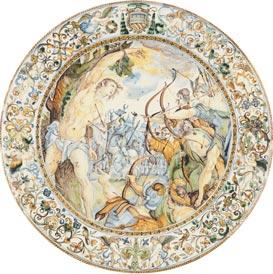
The development of the Castelli school of istoriato painting was spearheaded by Francesco Grue (1618–1673). The relationship of style between the two maiolica painters suggests that Berardino, who was from a family of potters from Anversa in the Abruzzi, may have worked for a time in association with Francesco Grue5
1 The reversing may be due to the use of a pounced copy.
2 The identification of the source is due to Paul Taylor of the Warburg Institute, London.
3 Catalogo delle collezioni private d’arte appartenute a S.A.R. Emanuele Filiberto di Savoia, duca d’Aosta, Rome (Giacomini), 15 February 1932, lot 306. Thanks are due to Franco G. Maria Battistella for this reference and for copies from the catalogue.
4 Arbace 2000, p. 150, fig. 124; Battistella and de Pompeis 2005, p. 78, fig. 120.
5 Arbace 2000, pp. 142–52; Battistella and de Pompeis 2005, p. 78.
125 Plaque
By Candeloro Cappelletti, Castelli, 1717
MAK, KE 6775
Hauptinventar no. 26070r
Bought from Neukloster, 1925
Tin-glazed on the front, unglazed on the back and sides
16 x 21.5 cm; T 1.7 cm
Condition: good
Bibliography: none
The plaque is painted with a landscape with towered buildings, Classical ruins, and tiny figures. On the unglazed back is the barely legible inscription Fecit An[n]o domini MDCCXVII Candelorus Cappeletti Terra Castelloru[m] (Candeloro Cappelletti made this at Castelli in the year of our Lord 1717)1
Candeloro Cappelletti (1689–1762)2 was the son of the sister of the eminent maiolica painter Carlo Antonio Grue. Only one other signed work by him is known, a Madonna and Child with Saint John, dated 17133; were it not for the signatures it would be difficult to identify the two works as by the same hand.
1 I thank Anne Biber for ultraviolet photographs enabling the word Candelorus to be read.
2 For his life dates, see Giacomini 2018, p. 58.
3 Battistella and de Pompeis 2005, p. 154. For Candeloro’s younger brother, Nicola, see Battistella and de Pompeis, pp. 159–61, with attributions to him of landscapes in the same general manner as, but seemingly not by the same hand as, the MAK plaque.
126
Plaque, Minerva leads Painting to the Liberal Arts
By Carmine Gentili, Castelli, c1700–1750
MAK, KE 7530
Hauptinventar no. 26070r
Transferred from Reichsstatthalterei, September 1939
Provenance: unrecorded
Covered on the front, but not the sides of back, with a white tin glaze
42.3 x 42.7 cm
Condition: broken and repaired. Conservation at Universität für angewandte Kunst, Vienna, 2021/22
Bibliography: none
The elaborate scene, an allegory of the merits of the art of Painting, shows the helmeted goddess Minerva (Pallas) leading Painting to join the Liberal Arts; a winged cupid flies down with a laurel wreath.
The scene closely follows (omitting a statue of Hercules in a niche upper left) an engraving by Aegidius Sadeler after Hans van Aachen1
The inscription top and bottom, damaged in parts, transcribes the Latin verses beneath the engraving, which are as follows:
Nobile si quid humus, si quid tenet Amphitrite, / Spectatu dignum si quid Olympus habet, / Aemula naturae dextra pictura potenti / Semper victuras transtulit in tabulas. / Sed rudis est omnis sine Pallade forma: / Si coniurarunt, pulchrius his quid erit? / Et comes ambabus si venerit incluta virtus, / Undique perfectum laurea cinget opus. (If the Earth holds something noble, if the Sea does, if the Heavens contain something worthy to be looked at, then skilled Painting, competing with mighty Nature, has transferred it to panels, which will live on forever. But all is rough without the form given by Pallas: if they are united, what will be more beautiful than these? And if their famous companion Virtue will join them, then the perfect work will be crowned with laurel.)
The last word of the verses, OPUS, serves double duty on the maiolica panel, since it is followed by GENTILI (“the work of Gentili”).
Carmine Gentili (1678–1763) is the best-known and was the most prolific member of a family that became one of Castelli’s principal maiolica dynasties2
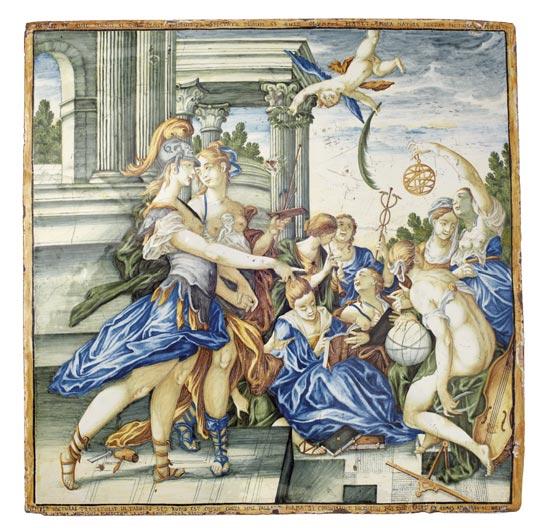
187 Bowl, FAUSTINA B[ELLA]
Urbino or Castel Durante, c1530–1540
MAK, KHM 36
Source: KHM (no. 2668)
Provenance: Imperial Schatzkammer, Vienna
Shallow bowl on low foot; tin-glazed front and back; the back undecorated
Ø 24.1 cm
Condition: good. At present in a metal hanging collar
Bibliography: Sacken 1870, p. 141; Vienna 1891, p. 102, case 4, no. 56; Planiscig and Kris 1935, p. 64, case 63, no. 7
“Faustina B[ella]”, expensively and exotically dressed, looks slightly downwards. For the classicizing name, see no. 22. She may possibly represent a courtesan.
188
Bowl, FRANCESCA B[ELLA]
Probably Duchy of Urbino, c1530–1560
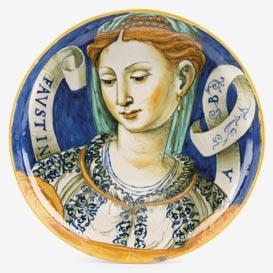
MAK, KHM 8
Source: KHM
Provenance: Obizzi-Este collection (E7851)
Shallow bowl with everted rim; tin-glazed front and back; the back undecorated
Ø 19.4 cm
Condition: broken and repaired
Bibliography; Planiscig and Kris 1935, p. 64, case 63, no. 8
“Beautiful Francesca,” in a high head dress, looks out sidelong at the viewer.
189
Plate, ANGELICA BE
Duchy of Urbino, c1540–1560
MAK, KHM 35
Source: KHM
Provenance: Obizzi-Este collection (E7844)
Labels: Este collection label with red crown and No. 743, a descriptive label in German with what is presumably a valuation, 1000–1200K
Plate with deep well, sloping rim; tin-glazed front and back; the back undecorated
Ø 17.8 cm
Condition: some wear
Bibliography: none
In the central well, a woman in an elaborate embroidered or lace collar looks straight out at the viewer; on a scroll ANGELICA.BE[LLA]. The border is painted with interlace incorporating cornucopias, animal heads, and a winged cherub head.
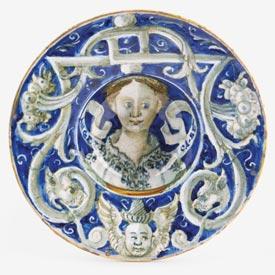
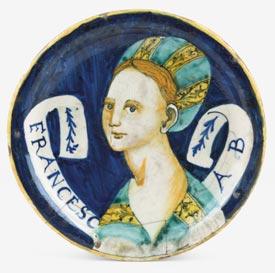
Fluted bowl, Bella donna
Probably Duchy of Urbino (Castel Durante?), c1540–1570
MAK, KHM 167
Source: KHM
Provenance: Obizzi-Este collection (E7871)
Shallow bowl, made by pressing into a concave mould with sixteen gadroons; tin-glazed front and back; the back undecorated
Ø 18.7 cm
Condition: the foot chipped away (probably to facilitate framing)
Bibliography: none
On a yellow ground a woman looks out threequarters at the viewer; her hand, with notably long fingers, reaches across her breast1
1 A plate in Pesaro, Giardini 1996, tav. X, has a similar yellow-ground figure within a border of a type associated with Castel Durante.
191
Plate, A woman with a basket of fruit
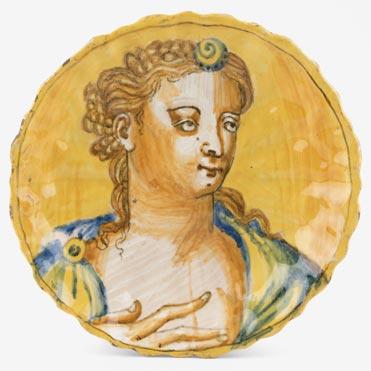
Perhaps northern Lazio, c1550–1600
MAK, KE 3537
Hauptinventar no. 8637r
Bought 1888 from Heilbronner, Munich
Flattish plate with small foot. Covered front and back with a whitish, probably tin, glaze; the back undecorated
Ø 22.4 cm
Condition: edge chips; the glaze scuffed and crackled overall
Bibliography: none
In a landscape with buildings and distant mountains a woman carries a basket of fruit. The plate has not been related to any work of definite origin and the attribution is hypothetical. A somewhat similar plate is attributed by Julia Poole to Deruta1
1 Poole 1995, no. 276. A plate similar to the MAK one, with Saint Margaret, belongs to the Fondation Bemberg, Toulouse , 4138.
